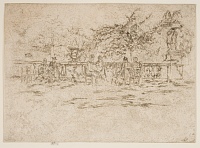The Little Terrace, Luxembourg Gardens, No. 2 | ||
| Number: | 444 | |
| Date: | 1889/1890 | |
| Medium: | etching | |
| Size: | 128 x 178 mm | |
| Signed: | butterfly at upper left | |
| Inscribed: | no | |
| Set/Publication: | no | |
| No. of States: | 1 | |
| Known impressions: | 2 | |
| Catalogues: | K.426; M.423 | |
| Impressions taken from this plate (2) | ||
KEYWORD
balustrade, conversation, park, sculpture, tree, vase, woman seated.
TITLE
Whistler's original title is not known. Variations on the title are as follows:
'The Little Terrace, Luxembourg Gardens, No. 2' (1903/1935, possibly Rosalind Birnie Philip (1873-1958)). 2
'The Terrace, Luxembourg Gardens' (1904, Grolier Club). 3
'Luxembourg Gardens' (1905, ISSPG). 4
'Terrace, Luxembourg Gardens. No. 3' (1909, Howard Mansfield (1849-1938)). 5
'Terrace, Luxembourg Gardens, No. 2' (1910, Edward Guthrie Kennedy (1849-1932)). 6
'The Little Terrace, Luxembourg Gardens, No. 2' is the preferred title, based on a title that may have originated with Whistler, and which was recorded on the envelope containing the copper plate. The first of the two related subjects is Little Terrace, Luxembourg Gardens 443. It would seem that Mansfield and Kennedy disagreed about which came first, and in fact there is simply no way of knowing.
'The Little Terrace, Luxembourg Gardens, No. 2' (1903/1935, possibly Rosalind Birnie Philip (1873-1958)). 2
'The Terrace, Luxembourg Gardens' (1904, Grolier Club). 3
'Luxembourg Gardens' (1905, ISSPG). 4
'Terrace, Luxembourg Gardens. No. 3' (1909, Howard Mansfield (1849-1938)). 5
'Terrace, Luxembourg Gardens, No. 2' (1910, Edward Guthrie Kennedy (1849-1932)). 6
'The Little Terrace, Luxembourg Gardens, No. 2' is the preferred title, based on a title that may have originated with Whistler, and which was recorded on the envelope containing the copper plate. The first of the two related subjects is Little Terrace, Luxembourg Gardens 443. It would seem that Mansfield and Kennedy disagreed about which came first, and in fact there is simply no way of knowing.
2: Envelope containing copper plate, University of Glasgow.
3: New York 1904a (cat. no. 352).
4: London Mem. 1905 (cat. no. 377).
5: Mansfield 1909[more] (cat. no. 423).
6: Kennedy 1910[more] (cat. no. 426).
DESCRIPTION
Women sit on a terrace, bounded by a balustrade that looks over a park. At left sit two women with two empty chairs to their left. Behind them is a pillar supporting a statue, tall trees in full leaf, and glimpses of buildings in the distance. To right of them, on the balustrade, is a large urn containing a flowering plant. In the centre are two women seated facing right, talking, and opposite them, two more women, possibly reading or knitting and looking out over the trees. The balustrade ends at the right with a pedestal on which stand two sculptured child-like figures supporting a broad bowl containing plants. Shadows fall across the foreground, which is otherwise bare.
SITE

The Statue, Luxembourg Gardens c095, lithograph 1893/1895,
The Hunterian, University of Glasgow (49209).
The Jardin du Luxembourg is one of the largest public parks in Paris, in front of the Luxembourg Palace, in the 6th arrondissement. In 1611, Marie de Medici, widow of Henry IV and regent for King Louis XIII, commissioned Salomon de Brosse to design the Luxembourg palace and a fountain in Italian Baroque style. A series of gardeners designed and extended the gardens. Tommaso Francini designed two terraces with balustrades and parterres laid out along the axis of the chateau, aligned around a circular basin. Jacques Boyceau de la Barauderie laid out a series of squares along an east-west alley ending at the Medici Fountain, and a rectangle of parterres in front of the palace, with, in the centre, an octagonal basin with a fountain.
After the French Revolution the architect Jean Chalgrin restored the garden, including the Medici Fountain, in formal French style.
From 1848, the park was filled with statues; first of famous French woman, along the terraces; and later (in Whistler's time), monuments to writers and artists.
Gabriel Davioud, director of parks and promenades, made additions to the buildings and layout of the gardens, keeping the regular geometric pattern of the pathways but adding a diagonal alley near the Medici fountain that opened a view of the Pantheon.
By Whistler's time the garden contained a marionette theater, a music kiosk, greenhouses, an orangerie and an orchard and dozens of statues. 7
7: SÚnat official website at http://www.senat.fr / visite/jardin/statues.html (accessed 2011).
